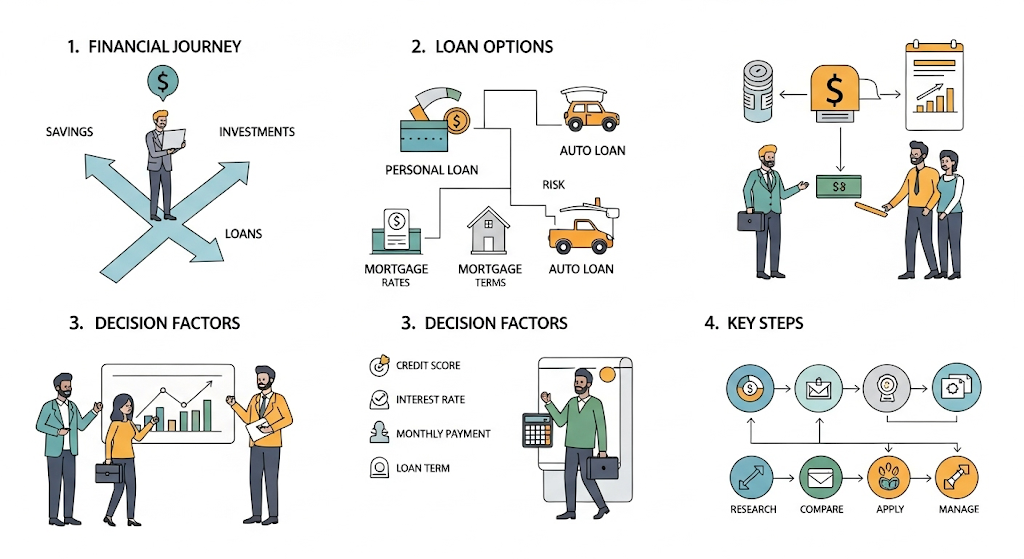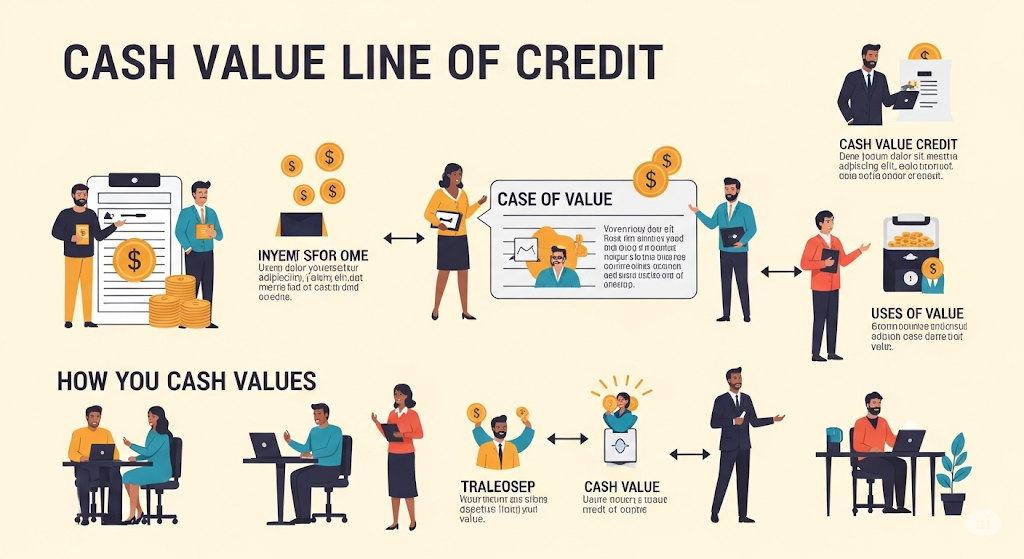
A cash value line of credit allows individuals to borrow against the cash value built up in their whole life or universal life insurance policy. It offers a flexible, revolving credit option that uses the policy’s cash value as collateral, typically at competitive interest rates. This can provide quick access to funds without the need to sell off other assets or disrupt long-term investments.
Many use this line of credit to consolidate higher-interest debt, cover personal expenses, or finance business opportunities. Since it is secured by the insurance policy, interest rates often compare favorably to credit cards or personal loans. Borrowers can usually take out funds on an interest-only basis, making it a potentially cost-effective borrowing tool.
Because the cash value line of credit taps into existing policy value rather than creating new debt, it can offer financial flexibility while preserving other resources. Understanding how it works and its potential uses is essential for anyone considering this borrowing option.
Understanding Cash Value Line of Credit
A cash value line of credit allows a borrower to tap into the accumulated cash value of a permanent life insurance policy. It functions differently from traditional loans or unsecured credit lines, combining access to funds with unique eligibility and repayment features. Key considerations include how it works, how it compares with other credit options, its advantages and drawbacks, and common eligibility criteria.
Definition and How It Works
A cash value line of credit is a borrowing option that uses the cash value of a life insurance policy as collateral. The policyholder can access funds by borrowing against this value without liquidating the policy. Interest accrues on the borrowed amount but repayment terms are typically flexible.
Accessing the line does not require a credit check, and the loan doesn’t impact the policy’s death benefit unless the loan balance exceeds the cash value. Borrowers can use the funds for personal or business needs, including options like construction loans or real estate investments.
Comparison With Other Lines of Credit
Unlike unsecured business lines of credit or guidance lines of credit, a cash value line is secured by the insurance policy’s cash value. This security often results in lower interest rates compared to unsecured options.
However, it differs from a construction line of credit or a real estate line of credit, which are typically secured by physical assets like property and involve stricter qualification processes. A cash value line can be accessed more quickly with fewer qualification barriers, which can prove helpful for short-term financial needs or how to open credit line for home auctions.
| Feature | Cash Value Line of Credit | Unsecured Business Line | Construction/Real Estate Line |
|---|---|---|---|
| Collateral | Cash value of life insurance | None | Property or project |
| Interest Rate | Generally lower | Typically higher | Moderate to low |
| Qualification | Based on policy status | Based on credit score | Based on asset valuation |
| Repayment Flexibility | Flexible | Often more rigid | Fixed terms |
Benefits and Drawbacks
The main benefits of a cash value line of credit include quick access to liquidity and relatively low interest rates. Because it leverages the policy’s cash value, it does not require appraisal or additional collateral beyond the policy.
Drawbacks include reduced death benefits if the loan isn’t repaid and the possibility of policy lapse if the loan balance grows too large. Additionally, it is not suitable for large financial needs beyond the available cash value and may not cover all scenarios such as certain business expansions.
Common Eligibility Requirements
To qualify for a cash value line of credit, the borrower must have a permanent life insurance policy with accumulating cash value, such as whole life or universal life insurance. The cash value must meet or exceed the minimum threshold set by the lender or insurer.
Borrowers often must be policyholders in good standing with no lapses in premium payments. Other conditions may exclude newer policies that haven’t built sufficient cash value. Unlike unsecured lines, credit scores have less impact, but lenders may still conduct basic financial reviews.
This type of credit is typically offered by banks, insurers, and financial institutions servicing states such as AL, FL, GA, MD, NC, SC, TN, and VA.
Types of Cash Value Line of Credit Options
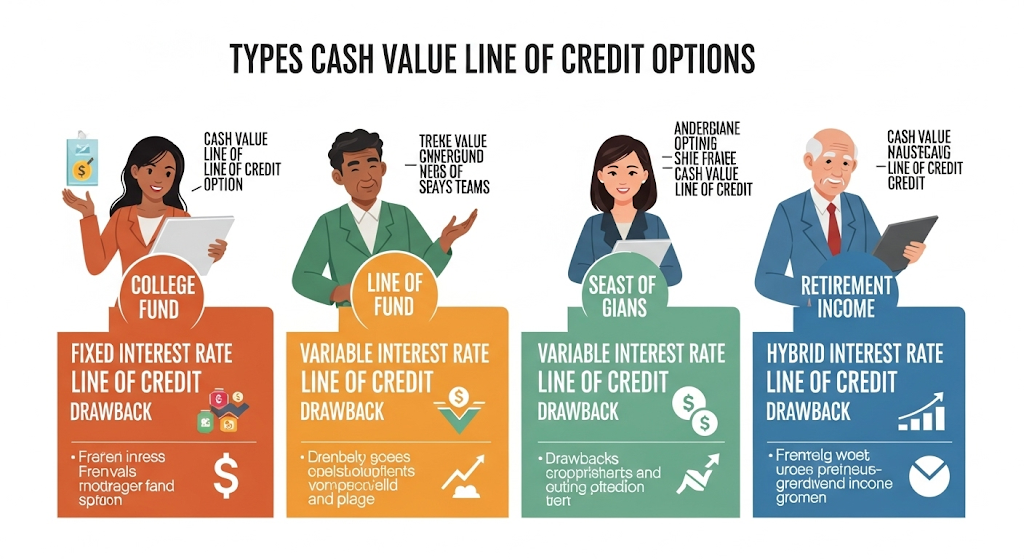
Cash value lines of credit use the cash value of a life insurance policy or other assets as collateral, offering flexible borrowing. These options vary by purpose and collateral type, impacting rates, repayment terms, and accessibility.
Home Equity Line of Credit (HELOC)
A HELOC allows homeowners to borrow against the equity in their property, often with a variable interest rate. It functions as a revolving credit line, making it suitable for ongoing expenses such as home renovations or debt consolidation.
Rates can differ significantly by location. For example, HELOC rates in Wichita, KS and Connecticut reflect regional lending conditions. Borrowers typically find these rates lower than unsecured loans because the home serves as collateral.
HELOCs generally require approval based on credit and home value, often holding a second lien position behind the primary mortgage, such as a 2nd position home equity loan in Daly City. This positioning influences lender risk and interest rates.
The open-ended nature lets borrowers withdraw funds repeatedly up to the limit during a draw period, with monthly interest-only payments usually required.
Business Line of Credit
A business line of credit provides companies with revolving access to funds for operations, inventory, or growth. It is commonly secured by assets including the owner’s life insurance cash value or business assets.
Banks in states like Tennessee offer tailored products such as a TN bank business line of credit, with terms varying by lender and creditworthiness.
This line of credit supports cash flow management by allowing flexible borrowing and repayment schedules without fixed lump sum disbursements.
Interest rates and limits depend on factors like business revenue and credit profile. Lines secured by policy cash values often provide better rates than unsecured business credit but require careful monitoring to avoid policy impact.
Personal Line of Credit
A personal line of credit offers individuals flexible borrowing with a preset credit limit and the option to draw funds as needed. It may be secured by cash value in a life insurance policy or other collateral.
Personal lines are often used to cover unexpected expenses or consolidate debt. This form of credit offers accessibility without asset liquidation.
The borrower repays interest only on the amount drawn, not the total credit line, which differs from traditional loans. Rates tend to be higher than HELOCs due to reduced collateral security.
Some banks may combine personal lines with policy collateral for lower rates and improved approval chances.
Closed End Home Equity Loan
A closed end home equity loan provides a lump sum with fixed interest and repayment terms, secured by home equity. Unlike HELOCs, it does not offer revolving credit or multiple draws.
Such loans often have predictable monthly payments and can be used for significant expenses like home improvements or debt refinancing.
Interest rates vary by state, with Virginia’s home equity loan rates representing a relevant example of fixed competitive terms.
Closed end loans usually hold a senior lien position on the property, which may differ from 2nd position loans.
Borrowers benefit from stable payments but lose the flexibility that lines of credit offer. This type is appropriate when borrowers need a known amount with fixed repayment.
Application and Approval Process
Applying for a cash value line of credit requires specific documentation and meeting eligibility criteria. The process involves verifying the policy’s cash surrender value and evaluating the applicant’s creditworthiness. Approval timelines vary depending on whether the line of credit is secured or unsecured.
Documentation and Information Needed
Applicants must provide details about their whole life insurance policy since the line of credit is secured by its cash value. Key documents include the policy statement showing the net cash surrender value and loan amount limits.
Personal identification, proof of income, and credit history may also be required to assess risk. Banks and lenders often request completed application forms with detailed financial information. This data helps determine available credit and assists in setting up automatic payment pools if required.
Steps to Qualify
Qualification starts with verifying the cash surrender value of the whole life policy, which typically must cover or exceed the requested credit limit. Some lenders require a minimum limit, commonly around $5,000.
The applicant completes an online or in-person application, submitting necessary documents. After initial review, a credit check may be performed. Approval can be quick, especially for secured lines of credit, sometimes within minutes to a few days.
Once approved, funds become available for use. Borrowers must arrange repayment methods and may need to set up automatic payments or link the line of credit to accounts managing recurring expenses like estimated tax payments.
Factors That Impact Approval
The primary factor is the policy’s accumulated cash surrender value. Lenders rarely approve credit limits exceeding this value or the maximum loan amount allowed by the insurance carrier.
Creditworthiness also impacts approval. A low credit score or high debt-to-income ratio can delay or reduce credit limits.
Collateral stability, such as whole life policy ownership and policy age, matters. Lines of credit tied to construction line of credit accounts may face stricter scrutiny to ensure funds match project timelines and payments.
Tips for a Successful Application
Applicants should confirm their whole life policy’s cash surrender value before applying to avoid surprises. Having updated policy statements and loan provisions ready speeds up the process.
Maintaining good credit and minimizing outstanding debts improves approval chances. Clear documentation of income and expenses reassures lenders about repayment ability.
Setting up automatic payment pools ensures on-time loan repayment and can prevent default. For applicants needing periodic funds, such as business owners managing Oregon estimated tax payments, organizing repayment schedules aligned with income flow is advisable.
Using a Cash Value Line of Credit
A Cash Value Line of Credit (CVLOC) allows access to the cash value of a life insurance policy for various financial needs. It offers flexible borrowing options, with structured repayment and potential risks that must be managed carefully.
Common Uses and Best Practices
A CVLOC is often used for expenses such as home renovations, business opportunities, or to handle immediate cash flow needs. It can also assist with large payments like automobile down payments or healthcare costs, including orthodontist payment plans and dental procedures like root canals.
Borrowers should use it to replace higher-interest debt, such as credit cards or personal loans, to reduce overall borrowing costs. Keeping borrowing within the policy’s limits—usually 92% to 95% of the cash value—is critical to maintaining policy stability. Applying the funds strategically ensures access to liquidity without compromising long-term benefits.
Cash Out and Repayment Strategies
Cash withdrawals from a CVLOC don’t trigger taxes as long as the policy remains in force. Borrowers usually repay interest only during the line’s term, which ranges from 2 to 5 years before renewal.
A strong repayment strategy involves making regular interest payments while planning lump sum or incremental principal repayments. Early repayment can reduce interest costs. Using the borrowed funds to pay for planned expenses like medical payment plans or a large purchase ensures controlled use of credit and effective cash management.
Managing Draw Periods
Draw periods specify when and how much can be borrowed. Most CVLOCs allow access up to a fixed percentage of the policy’s cash value. It is important to keep track of limits and renewals to avoid borrowing beyond available collateral.
Renewals occur every few years, requiring assessment of credit terms and cash value. Effective management involves projecting cash flow needs within draw periods and adjusting repayment schedules to prevent forced asset liquidation or policy lapse.
Potential Risks to Avoid
Using a CVLOC improperly can reduce the policy’s death benefit or cause it to lapse if loans are unpaid. Failure to track interest accrual and repayment deadlines can lead to increased debt.
Borrowers should avoid overborrowing or using the credit for non-essential spending. Using the CVLOC for discretionary expenses, instead of critical obligations like medical payment plans or down payments on automobiles, can jeopardize long-term financial health. Understanding these risks helps maintain the policy’s integrity while using the credit line wisely.
Rates, Fees, and Costs
A cash value line of credit involves various costs that borrowers need to understand before accessing funds. These include the interest charged, ongoing fees, and factors influencing how rates are set. Clear knowledge of these elements helps in managing expenses and comparing options effectively.
Interest Rate Structures
Interest rates on a cash value line of credit are typically variable, based on a benchmark such as the prime rate plus a margin. This means the rate can fluctuate with market conditions, affecting the cost of borrowing over time.
Some lenders may offer fixed-rate options, but these are less common. Rates often range from low single digits to rates comparable to traditional loans, depending on the borrower’s creditworthiness and the policy’s cash value.
For comparison, home equity line of credit (HELOC) rates, such as those in Wichita, KS, or Virginia, vary but generally fall between 5% and 8% annually. A Supernova payment structure might involve specific timing for interest calculation but does not commonly apply to cash value lines of credit.
Common Fees and Charges
Besides interest, borrowers may face recurring fees including:
- Annual or maintenance fees
- Origination fees
- Transaction fees when drawing funds
These fees vary by lender. Some providers, especially online entities like Inclined, promote no-fee structures, which can lower the overall cost.
Late payment and prepayment penalties are uncommon but can occur depending on the policy and lender. It is essential to review the fee schedule thoroughly before applying, as these costs add to the effective borrowing expense.
How Rates Are Determined
Lenders calculate rates based on several factors:
- The cash value available in the life insurance policy used as collateral
- The borrower’s credit score and financial history
- Current market interest rates, including prime rates and Treasury yields
Local factors can influence rates for similar credit products, for example, HELOC rates in Connecticut may be affected by regional economic conditions or regulatory changes.
The underwriting process includes assessing risk, with higher perceived risk leading to higher interest rates or fees. Therefore, well-established policies with substantial cash value generally secure better rates.
Alternatives to Cash Value Line of Credit
Different financing options offer varying terms, rates, and access to funds, which can be useful depending on individual needs and credit profiles. These alternatives include traditional loans, credit cards, and personal loans, each with specific advantages and limitations.
Traditional Loans
Traditional loans usually involve a fixed amount borrowed with set repayment schedules and interest rates. They are often secured by collateral such as property or other business assets, reducing the lender’s risk. This type of loan suits borrowers needing a lump sum for investments or major expenses.
Interest rates on traditional loans tend to be lower than unsecured credit, but the application process can be lengthy, requiring documentation and credit checks. Business owners might use secured loans to improve cash flow or purchase equipment, leveraging assets like real estate.
Credit unions can offer competitive traditional loan options with lower fees and interest rates compared to banks. These loans typically demand strong credit and sufficient collateral. Approval depends on the borrower’s financial history and the value of secured assets.
Credit Cards
Credit cards provide revolving credit that can be accessed easily for short-term financing needs. Business credit cards, including credit union business credit cards, often feature rewards or cash-back incentives alongside flexible repayment options.
They offer convenience but generally carry higher interest rates compared to secured loans or cash value lines of credit. Credit utilization impacts credit scores, so responsible usage is crucial. Cards like the AAMCO credit card may serve specific industry niches or businesses, but standard business cards remain widely available.
An item like “JPMCB card services” often appears on credit reports tied to JPMorgan Chase credit cards. Monitoring such entries helps users track payments and avoid fraud. Credit cards are best for expenses that can be repaid quickly to avoid accumulating costly interest.
Personal Loans
Personal loans are unsecured loans based on creditworthiness rather than collateral. They offer fixed rates and repayment terms, making budgeting predictable over the loan period. These loans suit individuals or business owners without substantial assets for collateral.
Interest rates vary widely depending on credit scores and lender policies. Personal loans can have faster approval than traditional loans but often at higher rates. They provide larger sums than credit cards but less flexibility than revolving lines of credit.
Borrowers seeking moderate funding without collateral may find personal loans practical. However, they should compare terms across lenders to secure the best rates and reduce overall costs. Personal loans remain a common alternative when other credit options are unavailable or unsuitable.
Legal, Tax, and Regulatory Considerations
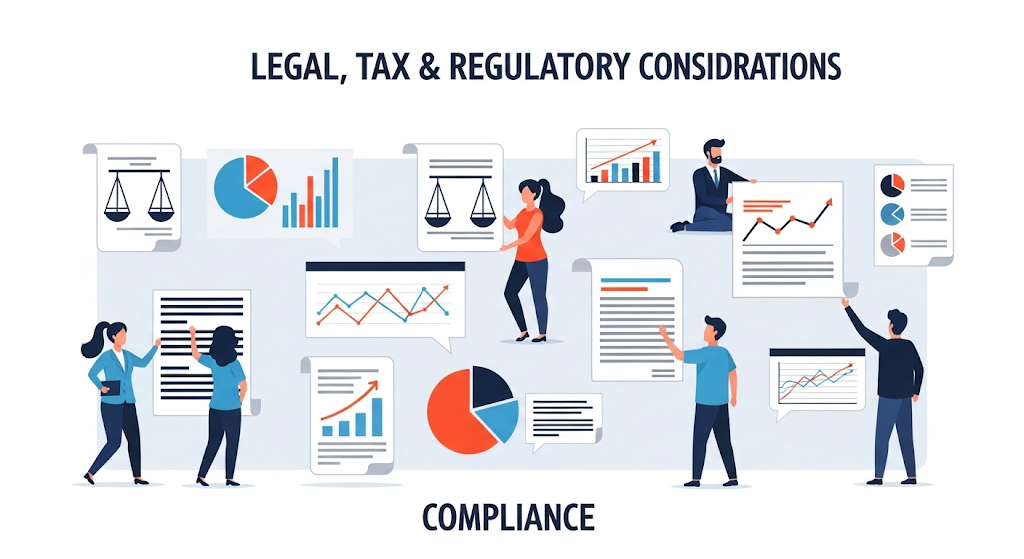
Cash value lines of credit involve specific legal timelines for debt collection, potential for disputes over repayment terms, and distinct tax rules that borrowers must understand.
Statute of Limitations for Debt
The statute of limitations sets a legal deadline for lenders to pursue debt collection. In Georgia, for example, the statute of limitations on credit card debt is six years. After this period, borrowers can legally refuse repayment without facing a court judgment.
This time frame begins when the borrower last made a payment or acknowledged the debt. For a cash value line of credit, tracking this date is crucial since unpaid balances can become difficult to collect beyond the statute window.
If a lender sues after the period expires, the borrower can raise the statute of limitations as a defense, preventing legal enforcement of the debt. However, the debt itself does not disappear and may still affect credit scores.
Potential Legal Disputes
Legal disputes commonly arise over repayment terms, interest calculation, or misuse of the credit line. Unlike loans with fixed terms, cash value lines of credit have revolving features that can cause confusion over the balance owed.
If no clear contract exists, as with some contractor payments, collection becomes more complex. In such cases, a contractor in Georgia can sue for nonpayment without a written contract but must prove a valid agreement or services rendered.
Disputes may also focus on whether interest rates comply with state usury laws or if fees were properly disclosed. Clear documentation and communication help reduce the risk of litigation in these situations.
Tax Implications for Borrowers
Borrowers do not incur taxable income by drawing on a cash value line of credit because it is a loan, not income. Interest paid on such lines may or may not be deductible depending on how the funds are used.
If the borrowed funds are used for business expenses or investments, the interest is often deductible. In contrast, personal use usually disallows this deduction.
Lenders typically recognize fees or costs over the life of the credit line on a straight-line basis for accounting purposes. Borrowers should keep detailed records to accurately report interest deductions and comply with IRS rules.
Security and Fraud Prevention
Security measures are essential to safeguard a cash value line of credit from unauthorized access or misuse. Understanding how to protect the credit line and recognizing common fraud schemes reduces the risk of financial loss and legal complications.
Protecting Your Line of Credit
Users should regularly monitor accounts for unusual activity and immediately report discrepancies. Strong authentication methods, such as multi-factor authentication, help prevent unauthorized access.
Financial institutions often provide alerts for suspicious transactions to mitigate risks linked to credit card abuse charges or other fraudulent activities. Using credit card reconciliation software can help track and verify payments, reducing errors or potential fraud.
For first-time offenses involving credit card theft or abuse, consequences may vary but staying proactive in security minimizes exposure. Knowing what constitutes felony credit card abuse or felony level credit card theft supports better compliance and awareness.
Common Scams and How to Avoid Them
Fraudsters commonly target cash value lines of credit through phishing emails, fake calls, or stolen identity tactics. Borrowers should never share personal or policy information via unsecured channels.
Suspicious requests for credentials or unexpected loan approvals are red flags. Verifying contacts through official bank channels is critical before providing any information.
Additionally, educating oneself about common scams and regularly updating passwords and security questions reduces the chance of falling victim. Financial institutions often educate clients on emerging fraud trends as part of their operational risk management.
Managing and Monitoring Your Line of Credit
Effective management of a cash value line of credit requires attention to daily balances, scheduled payments, and handling any payment problems promptly. Staying organized and using available tools can prevent fees and maintain good credit standing.
Tracking Balances and Transactions
Regularly tracking the outstanding balance and all transactions is essential. This includes reviewing withdrawals, repayments, and any fees applied to the account. Using online portals or mobile apps offered by lenders provides real-time access to these records.
Maintaining a record of transactions helps identify unusual charges, such as modern leasing MI charges on a credit card linked to the line of credit. This vigilance assists in budget planning and prevents overuse.
Setting alerts for balance limits and payment due dates can provide early warnings to avoid penalties. Monitoring utilization ratios closely also ensures the credit line is not overly relied upon, which can impact credit scores.
Automated Payment Options
Enabling automatic payments is a practical strategy to avoid late fees and keep the account in good standing. Borrowers can set up automatic payment pools where funds are drawn from a linked deposit account on scheduled dates.
Auto-pay can be configured to cover minimum payments, full balances, or set amounts based on the borrower’s cash flow needs. This flexibility helps maintain control over repayment without manual intervention.
Before enabling automation, it’s important to confirm that the linked account has sufficient funds to avoid overdraft charges. Regularly reviewing auto-pay settings ensures payments align with current financial conditions.
Dealing With Payment Issues
When payment difficulties arise, proactive communication with the lender is critical. Many institutions offer solutions such as temporary payment deferrals or revised payment schedules.
Ignoring missed payments can trigger penalties and damage credit ratings. Borrowers should immediately inform lenders to explore alternatives rather than waiting for automated collections.
If facing recurring payment challenges, reassessing the credit line usage and exploring more stable sources of financing may be necessary. Early intervention is key to minimizing financial impact and maintaining creditworthiness.
Impact on Credit Score and Financial Health
A cash value line of credit influences both credit reports and overall financial standing. Proper management can help improve credit profiles, while misuse carries the risk of increasing debt levels and harming creditworthiness.
How Lines of Credit Affect Credit Reports
A cash value line of credit is typically reported to credit bureaus, similar to other revolving credit accounts. It appears on credit reports often under the account name associated with the lender, such as JPMCB Card Services, which is JP Morgan Chase’s reporting entity.
The key factors impacted include payment history, credit utilization, and account age. Timely payments strengthen the payment history component, which constitutes 35% of most credit scores. Meanwhile, keeping balances low relative to the available credit helps maintain a favorable credit utilization rate.
Inquiries from new line of credit applications also show up on credit reports and may temporarily lower scores by a few points. Overall, this type of credit acts like a revolving account and is evaluated accordingly by scoring models.
Improving or Rebuilding Credit
Using a cash value line of credit responsibly can assist someone trying to improve or rebuild credit. Consistently paying at least the minimum due before the due date positively affects the payment history.
Keeping utilization below 30% is advisable to demonstrate prudent borrowing habits. This ratio reflects the amount of credit used versus credit available and heavily influences credit score calculations.
For people with damaged credit, adding a well-managed line of credit diversifies credit mix, which can improve FICO score performance. Over time, on-time payments and modest borrowing signal reliability to lenders.
Risks of Overleveraging
Overleveraging occurs when the borrower draws heavily on the cash value line of credit beyond their ability to repay promptly. High utilization rates—above 30% or more—can damage credit scores by suggesting financial stress.
If payments are missed or late, the negative effect multiplies, often causing sharp score declines and potential penalties. Excessive reliance on this credit can lead to a cycle of growing debt and limit future borrowing options.
Additionally, tapping into this credit line without a clear repayment strategy can strain financial health. It is essential to monitor balances, stay within repayment capacity, and avoid unnecessary new credit inquiries.
Special Use Cases and Related Payment Solutions
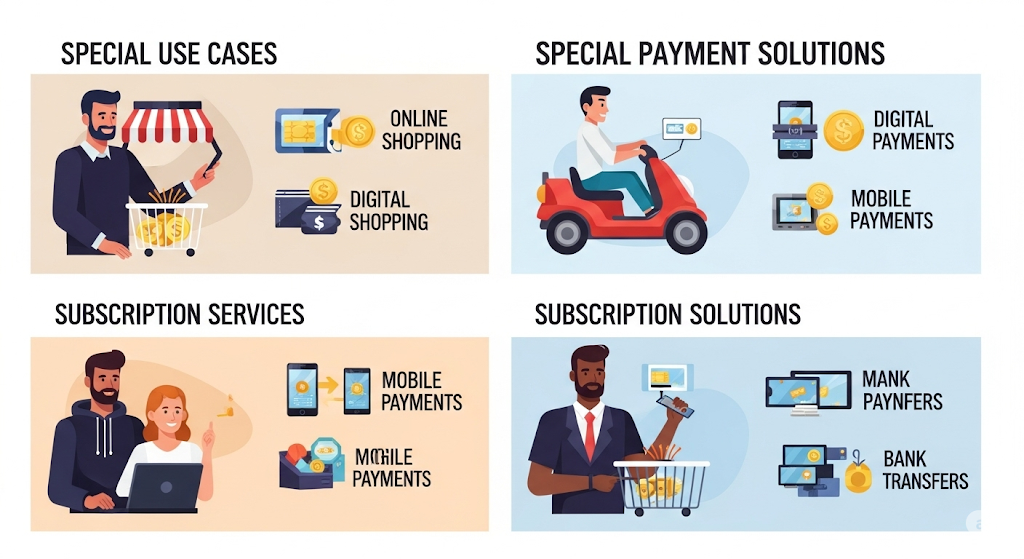
Cash value lines of credit (CVLOC) provide flexible access to funds and are often integrated with various payment and lending strategies. They can support specific financial needs such as down payments, unique government benefits, and advanced lending mechanisms. These solutions enhance liquidity without liquidating assets or incurring high-interest debt.
Payment Assistance Programs
Cash value lines of credit can be instrumental in automobile down payment assistance programs. Instead of using savings or high-interest loans, borrowers tap into their whole life insurance cash values to fund down payments, avoiding credit damage and maintaining financing flexibility. This method supports buyers who need quick access to capital without traditional financing hurdles.
In some cases, government payments such as the $1800 Social Security payment serve as supplemental income for individuals managing monthly cash flow challenges. CVLOCs complement such payments by offering an additional financial resource when those funds are delayed or insufficient for immediate expenses.
Unique Payment Situations
Certain historical and specialized payment methods illustrate the adaptability of cash value lines of credit. For example, military personnel formerly used the 5 Cent Military Payment Certificate to simplify currency exchange and protect against inflation during overseas deployment. Similarly, CVLOCs provide tailored credit access that can respond to unforeseen or unique financial circumstances, such as emergency expenses or business cash flow gaps, with minimal processing time.
This flexibility allows individuals and businesses to navigate irregular income streams or one-time large payments without disruption. Accessing a CVLOC offers a controlled and consistent solution in financial environments where traditional loans might not be practical.
Innovative Lending Solutions
Integrating CVLOCs within broader lending portfolios creates opportunities for innovation in credit management. Financial institutions increasingly pair cash value borrowing with automated payment solutions and real-time payment networks to streamline transactions and reduce operational risks.
Borrowers benefit from lower interest rates compared to unsecured credit lines and maintain the growth potential of their whole life insurance policies. Additionally, combining CVLOCs with real-time payment technology allows instant access to funds for critical expenses or investment opportunities, reinforcing the usefulness of these products in a rapidly evolving financial landscape.
Debit Card and Alternative Payment Methods
Debit cards and alternative payment methods offer distinct ways to manage funds, each with unique benefits influenced by credit standing, security features, and payment processing. Understanding these differences helps users optimize financial control and protection.
Debit Cards vs. Credit Lines
Debit cards allow immediate access to available funds in a bank account. Transactions typically deduct money directly from checking or savings accounts, making them useful for daily spending without accumulating debt. A Shazam debit card and electronic debit cards operate by routing transactions through specific networks tied to the user’s account balance.
Credit lines, such as cash value line of credit, provide borrowed funds up to a preset limit, enabling spending beyond current cash reserves. Unlike debit cards, they require repayment with interest. The difference between US debit vs. Visa debit often lies in network processing but both function by utilizing existing account funds rather than credit.
Debit transactions are typically recorded as decreases to an account, not accounts receivable, which applies more to credit sales and business invoicing.
Secured vs. Unsecured Payment Options
Secured payment methods require collateral or direct linkage to an asset or account. Debit cards are secured by the funds in the linked bank account.
Unsecured options, common in credit lines, do not need upfront assets but rely on creditworthiness and carry the risk of debt accumulation. For example, a debit card for bad credit crossword clue suggests prepaid or secured cards as alternatives for users with low credit who cannot access unsecured lines.
Alternative payment methods, including mobile wallets or pinless debit cards, often blur these categories by offering flexible authorization approaches without physical card presence, increasing convenience but demanding robust fraud protections.
Features and Security Measures
Modern debit cards use chip technology to reduce fraud risks, though issues like chip malfunction on debit cards can occur, potentially requiring manual entry or card replacement.
PIN protection is standard but some cards support pinless transactions for small-value purchases, enhancing speed while maintaining basic security through device or account verification.
International debit cards, such as the Bank of Bhutan international debit card, include features supporting multiple currencies and online payments, addressing cross-border transaction needs.
Users must monitor charges, like unexplained transactions at locations such as 100 Deerfield Lane, to promptly address potential fraud. Secure networks and real-time alerts improve safety for both debit and alternative payments.




